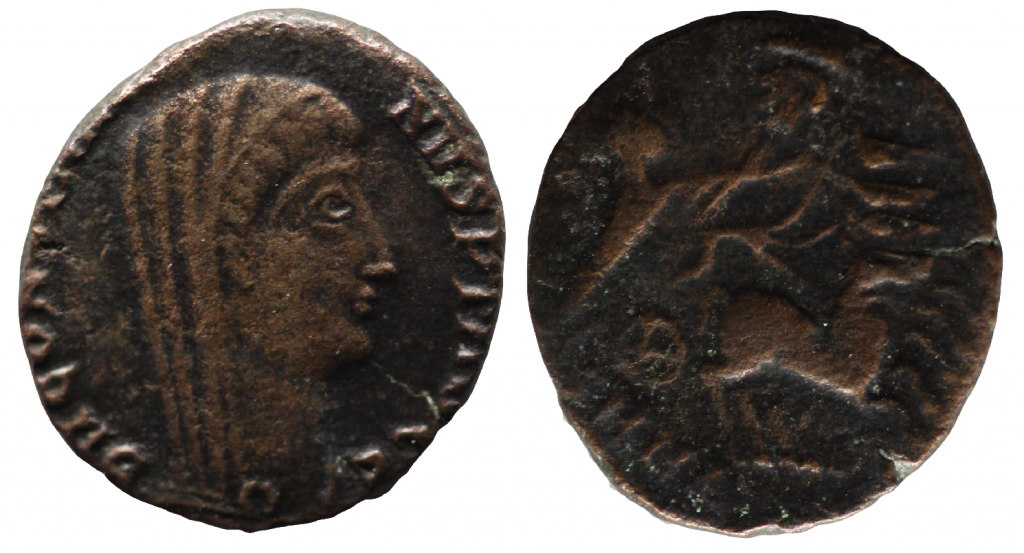May 22, 2015, by Will Leveritt
On this day in AD 337 Constantine the Great died
Text by Annabel Rock-Clarke
Image © Mint Imperials.
On the 22nd May AD 337, Constantine the Great died in the city of Nicomedia, in what is now Turkey. He had ruled for thirty-one years. Constantine was buried at the Church of the Holy Apostles in Constantinople and is remembered for being the first Christian Roman emperor.

AE15 showing deified Constantine. Issued under Constantine II Junior and Constantius II. Obverse shows Constantine the Great, veiled. DV CONSTANTINVS PT AVGG. Reverse has Constantine riding in a chariot up to heaven, stretching out towards the manus Dei. 15mm, 1.42g, 3 o’clock.
Flavius Valerius Aurelius Constantinus was born at Naissus, in modern day Serbia, probably around 272. His father, Constantius Chlorus, initially pursued a military career, but when the emperor Diocletian divided control of the empire in two in 286, his co-Augustus Maximian chose Chlorus as his Praetorian Prefect for the western half.
In 289, even closer ties were forged through the marriage of Chlorus to Maximian’s daughter Theodora. Then, in 293, when Diocletian instituted the tetrarchy – a system involving two senior emperors (the Augusti) and two junior emperors (the Caesares) – Chlorus was elevated to the position of Caesar of the West. Constantine’s mother was of humble origin and it unknown whether she was married to Constantine’s father at the time of his birth.
Constantine spent the majority of his youth at the imperial court of Diocletian and was educated in both Latin and Greek, although he is noted as favouring Latin throughout his life. The paranoia which permeated the tetrarchic system meant that Constantine was to some extent a political hostage, used by Diocletian to keep his father in check.
Nevertheless, Constantine fought for Diocletian and was a high-ranking courtier. It was from this vantage point that Constantine witnessed, first hand, the Great Persecution of the Christians which began in 303.
In May 305, Diocletian and Maximian, the two Augusti, abdicated, leaving their positions to their deputies: Galerius in the East and Constantine’s father, Chlorus, in the West.
Constantine then joined his father on a military campaign against the Picts in Britain. The following year his father died in Eboracum, modern day York, and although Constantine was declared emperor by the troops in Britain, the year 306 marks the beginning of his fight for power.
Constantine was forced to navigate the shifting political landscape that resulted from the collapse of the tetrarchic system in order to secure his position as emperor of the west. But Constantine had it in mind to secure control of the whole of Roman territory and rule as sole emperor.
To that end, in 312 he entered into battle with Maxentius, the son of Maximian, who was in control of Rome and Italy. According to accounts of Constantine’s life it was before this decisive battle, the Battle of the Milvian Bridge, that he experienced a vision of the cross in the sky, or, according to a different account, had a dream the night before.
Whatever the precise nature of Constantine’s experience, it was interpreted by the Christians in his entourage as a sign from God, and his revelation persuaded him to order his troops to paint on their shields the chi-rho, a symbol related to Jesus comprised of the first two letters of the Greek word for Christ.
The battle went Constantine’s way, and his victory persuaded him that Christianity was the one true religion. As a result of his conversion, he passed the Edict of Milan in 313, an edict of toleration which allowed his subjects to exercise their religion freely; in effect legalizing the practice of Christianity throughout the empire and ending the persecutions.
By 316 there remained only one obstancle to Constantine’s plan to rule alone: the eastern emperor, Licinius. After a period of uneasy peace between the two rulers, in 324 Constantine seized his chance, defeating Licinius at the Battle of Chrysopolis in September 324.
Thus Constantine reunited the whole empire under the rule of one man. Following this victory, Constantine founded the city of Constantinople which was eventually dedicated in 330.
On his death, the reunified Roman Empire was once again divided, this time between Constantine’s three sons: Constantine II, Constantius II, and Constans. Rivalries led to civil war, a conflict won in the end by Constantius II who became the empire’s sole ruler.
No comments yet, fill out a comment to be the first

Leave a Reply